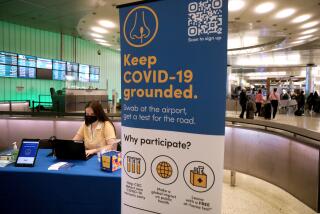Why did the government mandate a coronavirus quarantine?

At roughly 4 p.m. on Jan. 28, the Riverside County Public Health Department got word that nearly 200 Americans fleeing the novel coronavirus in Wuhan, China, would land at March Air Reserve Base the next day for a voluntary quarantine.
For the next 10 hours, local, state and federal officials — including those at Riverside, the Centers for Disease Control and Prevention, and the Department of Health and Human Services — scrambled to hash out preparation plans and gathered supplies to accommodate the incoming travelers who would be screened and monitored for the virus, dubbed 2019-nCoV, that had infected thousands.
The original plan was to send the travelers to Ontario International Airport, a site previously deemed a repatriation location, but the CDC had revised plans because of logistics. By 4 a.m. Jan. 29, health department staffers had activated a mobile health clinic on base and got into place to await the arrival.
“We didn’t have a lot of time, but this is what we practice for,” said Kim Saruwatari, director of public health for Riverside County.
After the World Health Organization’s declaration of a public health emergency related to the spread of the coronavirus, a Jan. 31 proclamation from President Trump suspended entry to the United States from those traveling from China and instructed officials to take “all necessary and appropriate measures to facilitate orderly medical screening and, where appropriate, quarantine of persons allowed to enter the United States who may have been exposed to this virus.”
In Riverside County, the voluntary quarantine was elevated to a mandatory quarantine — the U.S. government’s first since the smallpox outbreak in the 1960s.
In the time since, the group of 195 Americans has remained on March Reserve Air Base for the designated 14-day period — the incubation period for the virus. Two children were hospitalized after developing a fever; both were returned to base after testing negative for the virus. Those under quarantine are tested at least twice a day. According to Jarred Evans, an individual who has documented his quarantine on base, they have access to exercise options such as Zumba, and cards and board games to pass the time.
While Riverside health staff has managed day-to-day operations without difficulty or a diversion of resources from other public health areas, quarantine plans for those traveling from mainland China remain in place indefinitely.
“At some point they have to look at how the impact is in the long term,” Saruwatari said.
The State Department has reported that roughly 800 people have been evacuated from Wuhan since Jan. 29, most of whom will remain under quarantine in California at facilities tapped by the Department of Defense. Incremental and daily updates on the virus’ status have stirred fears and gripped communities throughout the country.
Officials have confirmed 12 cases of the virus in the U.S., six of which have been found in California, and have continued to press upon the public that the flu still poses a greater risk than the new coronavirus. The question that remains is why the government imposed a quarantine now, when no such mandate has been issued in over 50 years, despite the outbreak of disease.
The decision to quarantine does not align with the World Health Organization’s recommendations, which advise against a travel ban, and the CDC said the decision to mandate a quarantine was unprecedented.
The 2009 H1N1 pandemic — commonly referred to as the swine flu, which resulted in more than 60 million cases and more than 12,000 deaths in the United States over a one-year period — did not see a quarantine, for example.
Dr. Nancy Messonnier, director of the CDC’s National Center for Immunization and Respiratory Diseases, said the debate over quarantine has come up routinely during her 25-year career at the CDC. She said that a major difference between the coronavirus outbreak and 2009’s swine flu outbreak was that the latter was already on American soil by the time an outbreak was confirmed. The coronavirus, on the other hand, did not originate in the U.S. in such numbers and is believed to be transmitted directly from those traveling from mainland China. Officials believe that by quarantining those who may have traveled from the area, the virus will remain contained.
“What was different about this one is that the outbreak was caught so early before it really got to the United States,” she said. “But this is a situation where hopefully because of improved global capacity and surveillance and lab capacity, it was caught early before it spread around the world and we had this window of time in which we could intervene to slow it down. I think that is different from other situations that we faced.”
It’s difficult to quantify the effectiveness of a modern-day quarantine, a practice that was created in the 14th century in Venice, Italy, to prevent plague epidemics from spreading to coastal cities from ships that had returned to port.
“We’re a globally connected society today. It’s difficult to have an effective quarantine,” said Timothy Brewer, professor of medicine and a member of the Division of Infectious Diseases at UCLA’s David Geffen School of Medicine. “For a quarantine to really be effective, you have to be able to prevent any movement. That’s very difficult to do in this day and age.”
Brewer said that while a quarantine may not be a clear-cut solution, it’s one of the only tools available to mitigate today’s issue, as no vaccine exists and confirmed cases won’t test positive when they’re asymptomatic. Unlike an influenza outbreak like H1N1, in which people are show symptoms about 24 hours after catching the virus, the incubation period for the coronavirus is longer.
“Part of the thinking with coronavirus is the hope that it would act more like SARS and MERS coronavirus, where the most contagious individuals were the sickest individuals. If you have people who are sick before they’re capable of spreading a virus, that’s where screening and quarantines tend to be more effective,” Brewer said.
Politics may also have something to do with the decision, said Jennifer Nuzzo, enior scholar at the Johns Hopkins Center for Health Security.
“I do believe that politics played a role in our decision to implement these quarantines and travel [restrictions]. It’s not what health officials were talking about a few days earlier,” she said, adding that politicians called on the government to expand efforts, a “knee-jerk” reaction whenever a new virus emerges.
During the H1N1 outbreak, the U.S. was on the receiving end of such reactions from other countries. The U.S. pork industry, the largest in the world, took a $1.1-billion hit after more than 25 countries blocked pork imports from the U.S., fearing swine flu, even though the country was not directly connected.
Nuzzo said that she fears a similar response on the United States’ end in regards to China could prove detrimental in terms of the United States’ economic relationship with China, and the social impact such responses may have on Chinese Americans. In areas of California, fear of the coronavirus has fueled racist sentiment toward East Asian people.
“We have little to no evidence that [quarantines] work, and a lot of evidence that they do harm,” Nuzzo said.
During a House panel testimony Wednesday, Nuzzo said there are still several unknowns about the virus, including whether people have contracted it beyond China.
“Those types of circumstances make quarantines challenging because we don’t know who we should be quarantining fully,” she said.
Ron Klain, White House Ebola response coordinator under the Obama administration, echoed the sentiment. Less is known about the coronavirus today than what was known about the Ebola virus in 2014, he said.
In 2018, then-national security advisor John Bolton disbanded a unit inside the National Security Council tasked with the coordination of government-wide pandemic preparations following the Ebola outbreak. Klain insisted on the need for a key official inside the White House to oversee U.S. efforts to contain the virus.
“Epidemic response should not be a partisan issue,” he said.
More than 37,000 cases of coronavirus have been confirmed around the world, most of them in mainland China. More than 800 deaths have been reported, including one in the Philippines.
More to Read
Sign up for Essential California
The most important California stories and recommendations in your inbox every morning.
You may occasionally receive promotional content from the Los Angeles Times.











